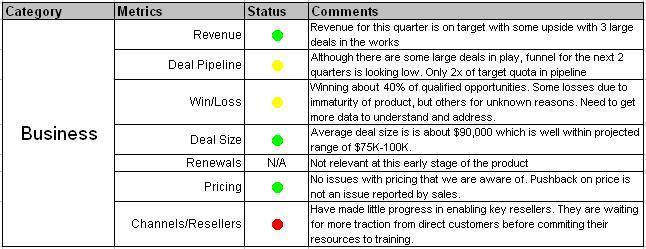Last week, I wrote about a Model and Metrics for Track Product Success.
Just to recap, there are 4 major areas I defined for tracking product metrics. These categories are:
- Business
- Go-to-Market
- Organizational Readiness
- Product
This week, I’m going to discuss how to define business-oriented metrics, and provide a simple way to track and report them.
What exactly is a “metric”?
The word “metric” is a bit of an ambiguous term. The dictionary definition doesn’t really help. The best general definition is:
n. a standard of measurement. A system of related measures that facilitates the quantification of some particular characteristic.
What we really want is a definition of a business metric.
n. A business metric is any type of measurement used to gauge some quantifiable component of a company’s performance.
Note, that even this definition covers a lot of ground. i.e. “any type of measurement”, and “some quantifiable component”.
3 rules for defining metrics
Metrics are only valuable if they either provide insight into an important aspect of your product, or are a leading indicator of potential problems ahead. Here are a few rules to help define useful metrics.
- Define metrics to align with key goals and objectives for your product. e.g. obvious business goals relate to sales or customer acquisition.
- Ensure that you can put programs in place to change those metrics if needed. i.e. there’s no point in tracking something if you can’t impact it in a meaningful way
- The actual metrics will be a combination of numeric values, as well as empirical evaluations of important situations.
And now for an example
The following is an example of some key business metrics for an early stage product. For this example, it is an enterprise software product that has been on the market for about 1 year and is starting to build traction in it’s target customer base.
The status (traffic light model) and comments are all that is needed for someone to get a clear understanding of the business state of that product.
The next obvious question for the yellow and red metrics is “Why?”
For example, why is the Deal Pipeline low? Is it lack of lead generation activities, or has there been proper follow up on generated leads to convert them into opportunities? Is it a lead quality issue? Or something else?
Other common questions are “How” or “When”?
For example, for the Channels/Resellers metric, although they are currently waiting for more traction, how much more traction is needed or when will there be enough traction to get the resellers interested? And then what is the plan to enable them?
The objective is to provide some clarity for tracking, evaluation, analysis and action for the product on a regular basis. This is a core aspect of product MANAGEMENT.
Next time, I’ll look at Go-to-Market and Organizational Readiness metrics.
Let me know what you think.
Saeed
Tweet this: @saeedwkhan Defining Business-Oriented metrics for Tracking Product Success http://wp.me/pXBON-2qb #prodmgmt
